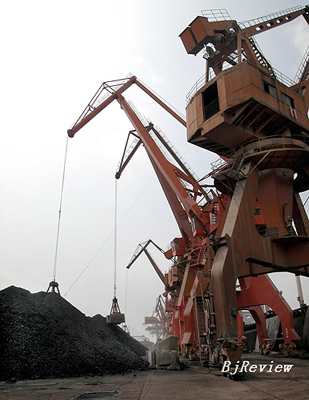
Recently, China has become the top choice for some coal exporters. This comes despite the fact that China used to be the world's second largest coal exporter and is still the world's largest coal producer today. The coal import-export balance took a historical turn in the first quarter of this year, and China may see greater imports than exports of coal the rest of the year.
The country imported 14.3 million tons of coal in the first three months of this year, a year-on-year rise of 60.7 percent, according to a report released by the National Development and Reform Commission on May 28. During the same period, China exported 11.41 million tons of coal, down 31.9 percent from last year, resulting in a net import volume of 2.89 million tons. China witnessed a net coal export of 7.89 million tons in the corresponding period last year.
Currently, China imports coal mainly from its neighboring countries such as Indonesia and Viet Nam. In the first quarter of this year, China imported 5.97 million tons from Viet Nam, a year-on-year increase of 40 percent, and 4.89 million tons from Indonesia, a year-on-year rise of 4.4 percent. Coal from the two countries accounted for 76 percent of the total coal imports in the first three months this year, a year-on-year increase of 18 percent.
"Coal imports could surpass exports in the world's largest coal producer mainly due to the leverage of the country's taxation policies," said Wu Chenghou, a consultant with the China Coal Transportation and Marketing Association.
Tax leverage
China, as the world's largest coal producer, has witnessed rapid growth in coal exports since the 1990s. Statistics from the National Bureau of Statistics (NBS) show that China exported 28.62 million tons of coal in 1995, with net exports amounting to 26.98 million tons. In 2003, China became the world's second largest coal exporter, with its coal exports standing at 94.03 million tons and net exports totaling 82.93 million tons. The country produced about 2.38 billion tons of coal last year, with the output doubling that of the United States as the world's second largest coal producer.
However, due to soaring domestic demands, China, the southern region in particular, once suffered from a shortage of coal despite the fact that coal production in China reached record levels several times. Energy-intensive industries represented by power generation, chemicals and metallurgy have gained great impetus in recent years, boosting domestic coal demands. The NBS statistics show domestic coal demand has grown by more than 20 percent every year since 2003. China's total installed capacity reached 620 million kw in 2006, ranking second globally and becoming a major factor behind the skyrocketing coal demands.
On November 1 last year, in order to ease the shortage of coal, the Chinese Government annulled the export tax rebate policy on coal exports and further reduced the coal import tariff rate from 3-6 percent to temporary 0-3 percent. At the same time, it levied a 5-percent export tariff on coal and coke product exports. Premier Wen Jiabao later proposed to strictly control the export of energy-intensive products at the executive meeting of the State Council when discussing the economic situation in the first quarter this year in April, showing that China is determined to restrict exports of natural resource products in the coming period of time. Furthermore, China is cutting export quotas on coal products, with the first group of quotas ratified this year standing at 42 million tons, much lower than last year's 64 million tons.
|
